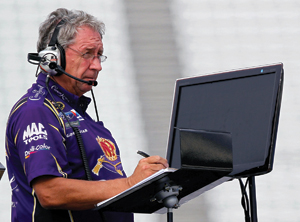The stupidest sports question I ever asked was, “What kind of cars do they race at the Daytona 500?” That was almost a year ago, when I found myself talking to Trevor Bayne and a couple of the marketing folks from Roush Fenway Racing at a conference in Chicago. I’ll admit, I knew less than nothing about the sport.
Thanks to an intervention by Tim Lister and Scott Warfield from NASCAR and John Bauersfeld from Roush Fenway, I’ve gotten a serious introduction. They have been my hosts at Infineon Raceway and at Homestead-Miami Speedway, for the championship race. Along the way I’ve become a fan. I find myself following the NASCAR community and always take a second look when I see NASCAR in the news.
As much as I like the sport, it’s the business side that really got my attention. I may be late to the NASCAR party, but I see a gold mine for smart brands.
My advertising agency has deep roots in business-to-business technology and health care, and I consider it my job to find untapped opportunities for our clients that give them an advantage against their competition. Until a year ago, I never would have looked at a NASCAR sponsorship. I saw a huge consumer market but not one that would be economical for a business-to-business audience. That all changed with some time at the track and a better understanding of the sport’s dynamics.
The fit for a mass-market consumer company is obvious. Who wouldn’t want access to 70 million loyal fans who give a preference to brands associated with NASCAR? A 36-week season and the large number of hours fans dedicate to the sport (six per week on average, according to NASCAR) provide an incredibly high degree of engagement, any marketer’s dream.
How can these dynamics work economically for a business-to-business audience?
Business-to-business sales are often more complex and involve multiple decision-makers. Then there’s the conventional wisdom that business-to-business customers are practical people who only care about product features and are immune to emotion. The good news is that a lot of those stereotypes no longer apply.
The lines between a business and consumer audience have totally blurred. Fans work on smartphones in front of the TV and play on Facebook at work. In this environment, to get someone’s attention, a brand must entertain them and make an emotional connection, whether they’re selling beer or enterprise technology.
More than anything, business-to-business brands need relevant content and stories to draw people to their websites and keep them there. What could be better than the NASCAR season, the longest running soap opera in sports? In addition to emotion and drama, it offers an ongoing story line that can be told on multiple levels.
 |
The role of a NASCAR crew chief offers management and leadership story lines for sponsors.
Photo by: GETTY IMAGES
|
The number and variety of stories playing themselves out each week still amazes me. At the Motorsports Marketing Forum in Las Vegas this past November, one of the speakers said, “It’s all about the driver. That’s all the fans care about.” I would argue that’s only a part of it. The drivers are huge; they are the gladiators. They’re wildly valuable marketing personalities, and the biggest consumer brands understand how to build campaigns around them. I also see dozens of undervalued, behind-the-scenes business stories, though, and the companies that can spot and package those stories before their competition can tap into a deep well of emotion and drama.
For example, a sponsor could take the team aspect of the sport and elevate it to a new level, totally on message for a business-to-business audience. The crew chief offers untold stories about management and leadership. Story lines could be built around technology innovations, race strategy, management theory and ROI. All of those stories draft on the excitement and suspense of race day but can be targeted narrowly to specific audiences.
Effective campaigns will look for ways to integrate NASCAR stories with their brand values. One of our clients develops electronic components that function under the most extreme physical conditions. A NASCAR relationship would help this brand bring real-life drama to products traditionally sold based on technical specs.
Green energy and building companies are creating relevant connections with NASCAR’s environmental story. Business software could likewise use NASCAR as a powerful differentiator in a crowded market where many brands look and sound the same.
The most wonderful story in the world is worthless without a place to tell it. For a business-to-business brand, that’s going to be a two-way street. For the full effect, they’ll need to make their brand visible at the track through traditional sponsorship activities. Depending on the target audience, that may mean advertising on NASCAR websites and on television. It may also mean promoting the brand through marketing channels that the sponsor controls: website, online customer communities, social networks, sales promotion programs and corporate events.
It’s through those marketing channels that a sponsor can really develop the NASCAR stories that it wants to own and that create a powerful association with its brand. These stories provide the content that business-to-business companies desperately need to attract people to their websites and to build ongoing relationships.
The trump card is that a thoughtful NASCAR marketing campaign lets a brand close the gap between event and digital marketing. No matter what sponsors think about the digital realm, the most powerful marketing campaigns are the ones that connect people in both the real and the digital worlds. The drama of NASCAR travels extremely well between the track and the Internet.
The best marketing opportunity is always the one that other people haven’t discovered yet. I see a sport with unique attributes and the door wide open for innovations between sponsors, teams, tracks and the NASCAR organization.
Phil Johnson (pjohnson@agencypja.com) is CEO of PJA Advertising + Marketing with offices in Cambridge, Mass., and San Francisco. Follow him on Twitter @philjohnson.





